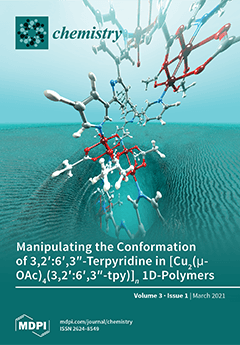We report the preparation and characterization of 4′-([1,1′-biphenyl]-4-yl)-3,2′:6′,3″-terpyridine (
1), 4′-(4′-fluoro-[1,1′-biphenyl]-4-yl)-3,2′:6′,3″-terpyridine (
2), 4′-(4′-chloro-[1,1′-biphenyl]-4-yl)-3,2′:6′,3″-terpyridine (
3), 4′-(4′-bromo-[1,1′-biphenyl]-4-yl)-3,2′:6′,3″-terpyridine (
4), and 4′-(4′-methyl-[1,1′-biphenyl]-4-yl)-3,2′:6′,3″-terpyridine (
5), and their reactions with copper(II) acetate. Single-crystal structures of the [Cu
2(μ-OAc)
4L]
[...] Read more.
We report the preparation and characterization of 4′-([1,1′-biphenyl]-4-yl)-3,2′:6′,3″-terpyridine (
1), 4′-(4′-fluoro-[1,1′-biphenyl]-4-yl)-3,2′:6′,3″-terpyridine (
2), 4′-(4′-chloro-[1,1′-biphenyl]-4-yl)-3,2′:6′,3″-terpyridine (
3), 4′-(4′-bromo-[1,1′-biphenyl]-4-yl)-3,2′:6′,3″-terpyridine (
4), and 4′-(4′-methyl-[1,1′-biphenyl]-4-yl)-3,2′:6′,3″-terpyridine (
5), and their reactions with copper(II) acetate. Single-crystal structures of the [Cu
2(μ-OAc)
4L]
n 1D-coordination polymers with L =
1–
5 have been determined, and powder X-ray diffraction confirms that the single crystal structures are representative of the bulk samples. [Cu
2(μ-OAc)
4(
1)]
n and [Cu
2(μ-OAc)
4(
2)]
n are isostructural, and zigzag polymer chains are present which engage in π-stacking interactions between [1,1′-biphenyl]pyridine units. 1D-chains nest into one another to give 2D-sheets; replacing the peripheral H in
1 by an F substituent in
2 has no effect on the solid-state structure, indicating that bifurcated contacts (H...H for
1 or H...F for
2) are only secondary packing interactions. Upon going from [Cu
2(μ-OAc)
4(
1)]
n and [Cu
2(μ-OAc)
4(
2)]
n to [Cu
2(μ-OAc)
4(
3)]
n, [Cu
2(μ-OAc)
4(
4)]
n, and [Cu
2(μ-OAc)
4(
5)]
n·
nMeOH, the increased steric demands of the Cl, Br, or Me substituent induces a switch in the conformation of the 3,2′:6′,3″-tpy metal-binding domain, and a concomitant change in dominant packing interactions to py–py and py–biphenyl face-to-face π-stacking. The study underlines how the 3,2′:6′,3″-tpy domain can adapt to different steric demands of substituents through its conformational flexibility.
Full article





